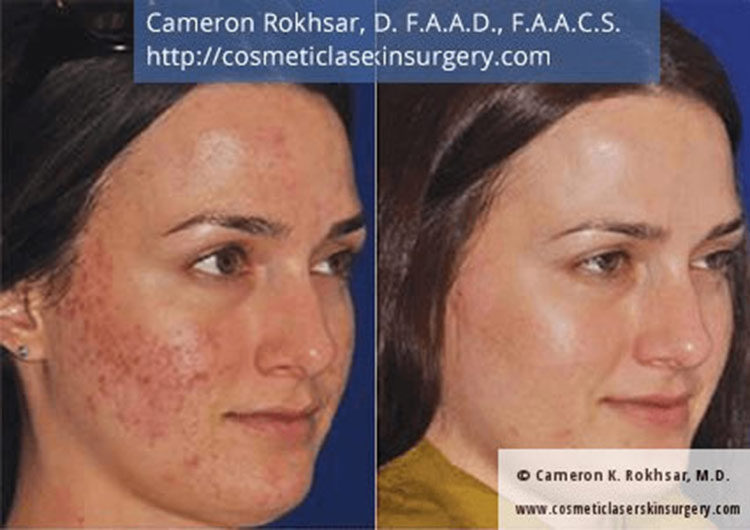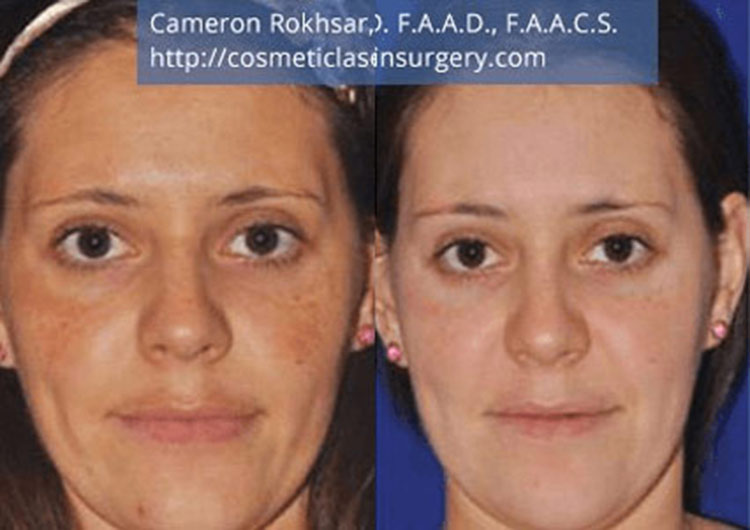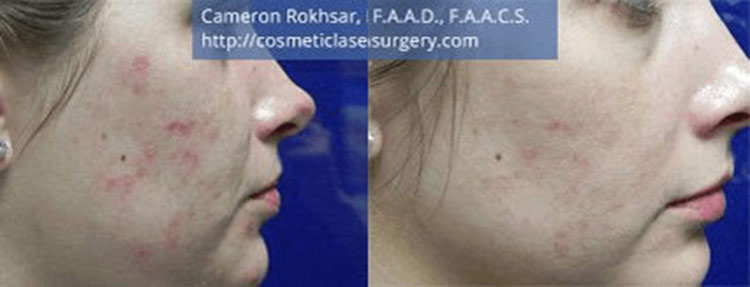Microneedling Skin Treatment in New York
Your skin has amazing rejuvenation powers and abilities. Think about every scrape you’ve had, every small cut–they’ve all healed and, over time, left almost no indication they were ever there. That’s because your skin is constantly renewing itself. Microneedling1 takes advantage of your skin’s amazing rejuvenation abilities to turn aged skin into more youthful-looking skin. This is accomplished by making many tiny “cuts” along the surface of the skin. These “cuts” trick the skin into thinking it has been damaged, and all of those healing powers kick into high gear. But because there’s no substantial damage to heal, those “powers” are then turned toward rejuvenation.
The minimally invasive skincare collagen induction therapy releases2 all kinds of collagens and other healing, helpful chemicals that are locked up in the skin. In most cases, this treatment is used to address the following:
- Fine lines and wrinkles
- Age spots
- Acne scars
- An overall appearance of aging
- A loss of “radiance” in the skin
- Loose skin
If you think you might be a good candidate for a microneedling session3, contact us to schedule your consultation. Our aesthetician will be able to tell you the benefits of microneedling, precisely what skin resurfacing can accomplish and what it cannot.
Microneedling Before and After Photos
*Results may vary.
The Microneedling Procedure
During your Microneedling or Dermapen treatment in New York, the procedure will be performed by a highly qualified professional using a device with sterilized needles. This device will make hundreds of tiny incisions (measured in fractions of millimeters) of depth depending on your desired final results. This may leave your face looking red and there may be a small amount of blood. However, it should take only a few days for this redness to subside and most of our patients return to work the day after the procedure. The results become visible after a few days, and those results can include smoother skin, fewer wrinkles, and a more radiant appearance.
If you want to see what Microneedling can do for you, contact us right away. The procedure itself can often be performed in less than 30 minutes, meaning there’s only minimal interruption to your day-to-day life. Get started right away by scheduling a confidential consultation. Your transformation could be right around the corner!
Microneedling FAQ
What is radiofrequency microneedling?
Radiofrequency microneedling is a cosmetic procedure that uses tiny needles and radiofrequency waves to rejuvenate facial skin. The treatment is a form of controlled skin injury that causes coagulation in the tissues and promotes collagen production, resulting in an improvement in mild wrinkles, acne scars, and mild skin tightening. The RF microneedling devices use specially insulated needles that deliver high-intensity radio frequency energy into the targeted tissue once the needles have broken through the skin. The procedure can effectively treat a range of concerns, including uneven skin texture, large pores, fine lines, wrinkles, stretch marks, sagging skin, hyperhidrosis, surgery scars, and sun-damaged pigmentation. RF microneedling is a non-invasive skin rejuvenation treatment that enhances the collagen-boosting benefits of microneedling with the heat of radiofrequency energy. The treatment is a potent combination of two therapies and is performed by experienced board certified dermatologists. The full-face RF microneedling treatments take about 45 minutes, with usually no downtime apart from slight reddening of the skin. The procedure is suitable for most skin types and can be customized to meet individual patient needs.
How does microneedling work?
By creating microscopic channels in the skin, microneedling triggers the body’s natural repair process, leading to the regeneration of new skin cells and the formation of new collagen fibers. This can help improve the appearance of a wide range of skin concerns, including wrinkles, fine lines, acne scars, enlarged pores, and uneven skin texture. Microneedling can be performed using a manual roller or an automated pen device, and a numbing cream may be applied before the procedure to minimize discomfort.
What serums to use during microneedling?
It is recommended using a hydrating serum during microneedling to help replenish and plump the skin. Hyaluronic acid-based serums are a popular choice because they are deeply hydrating and can help maximize the benefits of microneedling. Other serums that can be used during microneedling include peptides, ceramides, and PRP.
It’s better to avoid using serums that contain acids (AHA, BHA, and lactic acid) and retinoids during microneedling as they can be too harsh for the skin and cause irritation. Additionally, it’s best to use a clean canvas when performing microneedling, so make sure to cleanse your skin with a gentle cleanser and use an anti-microbial mist or pad to ensure a clean surface for microneedling.
How long does microneedling last?
The duration of the results of microneedling varies from person to person, and it depends on several factors such as the condition being treated, the age and health of the individual, and the number of sessions received. In general, the results of microneedling can last anywhere from six months to one year. However, maintenance treatments may be required to maintain the desired results.
The aftercare of microneedling is crucial to the success of the procedure. After the treatment, the skin may appear red and inflamed for up to 48 hours, and there may be some flaking or peeling of the skin. Patients should avoid using harsh skincare products and direct sun exposure for at least a week after the procedure. Proper hydration and the use of sunscreen are also important to maintain the results of microneedling.
What is microneedling good for?
This procedure can be used to address various skin concerns, including reducing the appearance of scars, including acne scars, fine lines, and wrinkles, minimizing enlarged pores, improving skin elasticity, and reducing hyperpigmentation, stretch marks, and other skin texture irregularities. Microneedling can be performed on different parts of the body, including the face, neck, chest, arms, legs, and abdomen. The benefits of microneedling may vary depending on the individual’s skin condition and the severity of their concerns.
What to expect after microneedling?
After the microneedling procedure, it is common to experience some temporary side effects, such as swelling, redness, and flaking of the skin. Most people can return to their regular makeup routine within a day or two after the treatment, but it is essential to avoid direct sun exposure and use sunscreen to protect the treated area. You may also experience some dryness or mild discomfort as the skin heals, but this typically resolves within a few days. Overall, the skin will likely have a smoother, more even texture and a more youthful appearance as a result of the treatment.
How often can you do microneedling?
It is recommended that patients space out their microneedling sessions by at least four to six weeks. This allows your skin enough time to fully heal and for the benefits of microneedling to manifest. The frequency of your treatments will depend on various factors, including the intensity of the treatment, the condition being treated, and your aesthetic goals. For optimal results, Dr. Rokhsar recommends three to six treatments spaced out every four to six weeks. However, if you are trying to improve the appearance of acne scars or deep wrinkles, you may need additional sessions of microneedling.
Why is my skin darker after microneedling?
Microneedling is a popular treatment for improving skin texture and stimulating collagen production, but it can cause temporary discoloration and darkening of the skin in some individuals. This discoloration is typically caused by skin inflammation and can lead to hyperpigmentation.
The degree of discoloration and hyperpigmentation after microneedling can vary depending on the aggressiveness of the treatment and the individual’s skin sensitivity. Aggressive treatments may cause redness, inflammation, and swelling, which can increase the risk of hyperpigmentation. Darker skin types are more susceptible to hyperpigmentation after microneedling, as they naturally contain more melanin, which can react to the inflammation caused by the treatment.
To minimize the risk of hyperpigmentation after microneedling, it is important to avoid excessive sun exposure and to wear a broad-spectrum sunscreen daily.
What to do after microneedling?
Immediately after your microneedling treatment, you should apply a cool compress to any areas that are red or swollen. It’s crucial to avoid touching or rubbing your face, as this can increase the risk of infection and irritation. You should also gently cleanse your skin with a mild cleanser to remove any debris or bacteria that may have been introduced during the procedure.
Following your microneedling treatment, Dr. Rokhsar recommends avoiding any skin rejuvenating products such as retinol, retin-A, vitamin C, AHAs, or BHAs. These ingredients can be too harsh on the skin and may cause irritation. Instead, he suggests applying a hydrating serum or moisturizer to nourish the skin and stimulate collagen production. Many dermatologists recommend using hyaluronic acid immediately after microneedling to help stimulate collagen production as the channels for absorption close rapidly.
It’s also essential to avoid direct sun exposure and wear sunscreen every day to protect your skin from UV rays, which can harm the skin and cause hyperpigmentation. During the first few hours after your microneedling treatment, you should also avoid washing your face and not use makeup or any brush on your face.
How to treat breakouts after microneedling?
Breakouts after microneedling can occur due to several reasons, such as tiny punctures in the skin that can cause the release of certain inflammatory substances or stimulate the growth of new skin. If breakouts occur, it is important to keep the skin clean and hydrated with gentle cleansers and moisturizers. Avoid picking or squeezing the breakouts as this can worsen the inflammation and lead to scarring. Dr Rokhsar can prescribe oral antibiotics to calm down any breaks as a result of microneedling.
New York Office Locations
Upper East Side Manhattan Office
121 East 60th Street, Suite 8AB New York, NY 10022
(212) 285-1110
Long Island Office
901 Stewart Ave, Suite 240, Garden City, NY 11530
(516) 512-7616
Request an Appointment
References
- 1 Microneedling: Collagen Induction Therapy. Available: https://www.healthline.com/health/microneedling.
- 2 Microneedling. Minimally Invasive Procedure. Available: https://www.webmd.com/beauty/what_is_microneedling.
- 3 Microneedling. Available: https://www.ncbi.nlm.nih.gov/books/NBK459344/.






 Dr. Rokhsar was chosen by
Dr. Rokhsar was chosen by 






